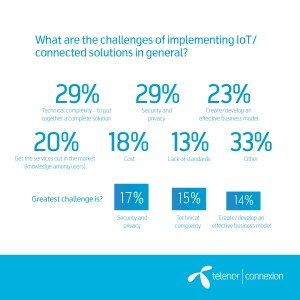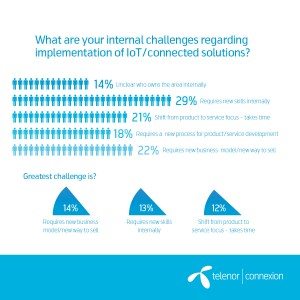Telenor Connexion was at Telematics Munich this week showcasing their “Internet of Things” (IoT) solution. In addition to connecting vehicles, they are also connecting homes, businesses, wearables including sporting goods and sheep. Yes, I said sheep, but more on that later.
Telenor Cloud Connect is the platform to support these efforts and incorporates the device (hardware and/or software), communications connectivity (GPRS/3G), application management and professional services to help users get up and running. The core part of the service is a cloud-based platform that allows the data to be captured and analyzed in the form of a visual interface to make decisions about your business. Also available as a mobile application, the global solution provides access to 400 mobile networks worldwide.
During this past summer, Telenor Connexion worked with Norstat to conduct a survey of 100 Swedish manufacturing companies related to the use of IoT in this market. The entire set of published results can be accessed via this link.
 There are a few that are worth highlighting in conjunction with this discussion. The amount of companies that have already implemented or plan to implent IoT within the next two years was 77%. The Nordic countries always seem to forge ahead with new technologies as market leaders, but this was a surprisingly high positive answer to this question and it’s great to see this technology being embraced.
There are a few that are worth highlighting in conjunction with this discussion. The amount of companies that have already implemented or plan to implent IoT within the next two years was 77%. The Nordic countries always seem to forge ahead with new technologies as market leaders, but this was a surprisingly high positive answer to this question and it’s great to see this technology being embraced.
 The general challenges associated with implementing an IoT solution were mainly around the technical aspects. The feeling or actual experience that this was a technical challenge and there were security and privacy issues that could be difficult to address were the highest-ranking items.
The general challenges associated with implementing an IoT solution were mainly around the technical aspects. The feeling or actual experience that this was a technical challenge and there were security and privacy issues that could be difficult to address were the highest-ranking items.
 Internally there were also challenges that needed to be addressed. The top of the list pertained to new skills required within the organization and the internal shift of considering products vs. services.
Internally there were also challenges that needed to be addressed. The top of the list pertained to new skills required within the organization and the internal shift of considering products vs. services.
You can see where the highlighted challenges lend themselves to working with an organization like Telenor Connexion, which can solve the requirements of complexity, security and management with their external team.
But let’s not forget the sheep. In Norway, the government will reimburse farmers who have had their sheep killed by a wolf in order to purchase a replacement for their herd. There’s a catch though, they have to produce the dead sheep. With IoT the farmers can monitor when their sheep stop moving for too long and be able to locate that animal for reimbursement.
I love to hear all of these innovative examples as to how IoT has the opportunity to change so many business models around the world.

